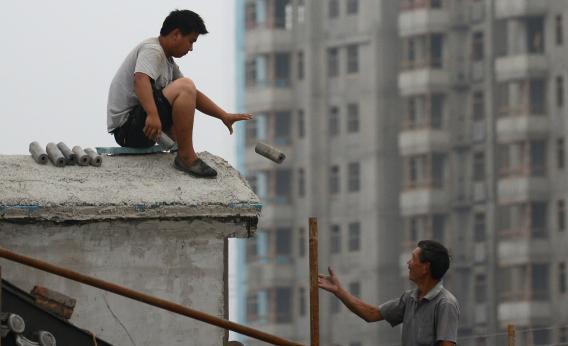Ever since 2008 or so I’ve been hearing that China’s investment-heavy export-led growth model is running on fumes and the country is headed for a collapse. Since those warning signs first became prominent in the media, the Chinese economy has close to doubled in size but the day of reckoning now appears to be upon us. And it all makes sense. The Chinese economy is so big now that its exports can’t keep growing and growing faster than the world economy—there’s nobody to buy the stuff. Even worse, since China now isn’t nearly as poor as it was 10 or 15 years ago, its wage advantage in low-end manufacturing has been lost to other Asian producers. Those limits to export-led growth impose limits on growth driven by investments. For a little while, with enough credit expansion you can make anything happen. But if nobody’s there to buy the stuff then ultimately investments in the facilities to make the stuff won’t pay off.
It can’t go on forever! Read Kate MacKenzie for a very thorough rundown of the logic of the bear case. A logic that, I hasten to emphasize, is now backed up with very real data of a very real slowdown in the Chinese economy.
But here’s what I don’t get: Housing. Investment, you’ll recall, includes “residential investment” (i.e. houses) and I don’t understand why it would be the case that China is oversatured with residential investment. Now yesterday someone showed me this photo slideshow of the Chinese ghost city of Chenggong and it took me about five minutes to realize that this was actually a different ghost city from the ghost city of Ordos. Whole brand new cities full of vacant buildings certainly seems like good evidence that China is oversatured with residential investment. But why would that be? Is this average Chinese person living in a mansion? When I visited China back in 2009 I saw a couple of newly built dwellings that looked to me like they’d be considered cramped by European standards, to say nothing of the vast expanses inhabited by Americans, Canadians, and Australians. Now that wasn’t a representative sample and perhaps things have changed in the past few years. But those were the houses that government officials wanted to show off to visited journalists! Looking out the window from trains you could see plenty of people living in peasant huts. And aren’t we always reading about Foxconn workers living four to a room in dormitories? And aren’t we also always reading about how by Chinese standards, a Foxconn job is a pretty good job?
So why not investment in some proper apartment buildings for factory workers to live in? Not brand new ghost cities, but just new buildings with larger dwelling units located in-or-around the cities and towns that China already has?
After all, this is exactly the kind of investment that would need to lead a “rebalancing” toward domestic consumption. My consumer goods are mostly in my house. My clothing is in my closet. My appliances are in my kitchen. When I moved from a smaller home to a larger one, I bought more chairs and a second couch. People keep cars in garages. At any rate, nobody’s out there making a bullish case for China and I’m not going to stick my neck out. But I think the slowdown is a bit more mysterious than simple invocation of “overinvestment” tells us. Something or other is creating ghost cities rather than bigger houses that people want to live in.
